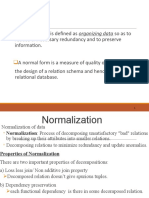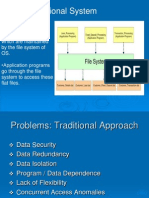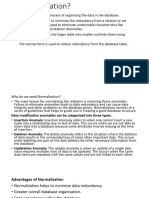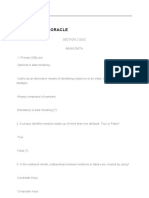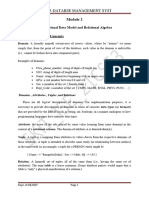0% found this document useful (0 votes)
31 views49 pagesNormalization
The document discusses the process of normalization in database design, detailing various normal forms (1NF, 2NF, 3NF, BCNF, and 4NF) based on keys and functional dependencies. It explains the importance of normalization to eliminate redundancy and anomalies, as well as the definitions of keys, attributes, and the practical use of these normal forms in achieving high-quality relational designs. Additionally, it covers decomposition techniques, lossless and lossy joins, and properties of decomposition to maintain data integrity.
Uploaded by
sohamparab38Copyright
© © All Rights Reserved
We take content rights seriously. If you suspect this is your content, claim it here.
Available Formats
Download as PDF, TXT or read online on Scribd
0% found this document useful (0 votes)
31 views49 pagesNormalization
The document discusses the process of normalization in database design, detailing various normal forms (1NF, 2NF, 3NF, BCNF, and 4NF) based on keys and functional dependencies. It explains the importance of normalization to eliminate redundancy and anomalies, as well as the definitions of keys, attributes, and the practical use of these normal forms in achieving high-quality relational designs. Additionally, it covers decomposition techniques, lossless and lossy joins, and properties of decomposition to maintain data integrity.
Uploaded by
sohamparab38Copyright
© © All Rights Reserved
We take content rights seriously. If you suspect this is your content, claim it here.
Available Formats
Download as PDF, TXT or read online on Scribd
/ 49


















